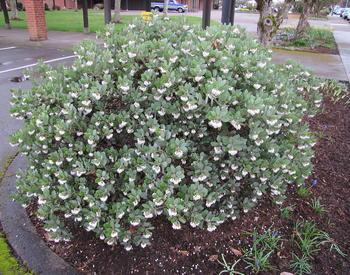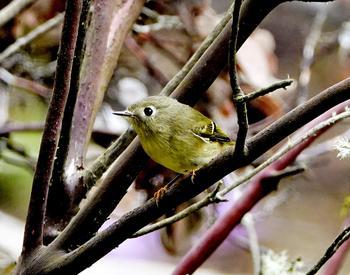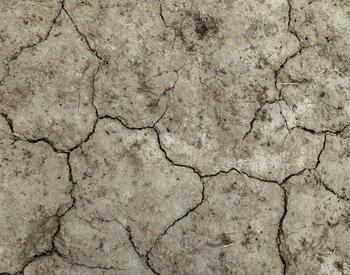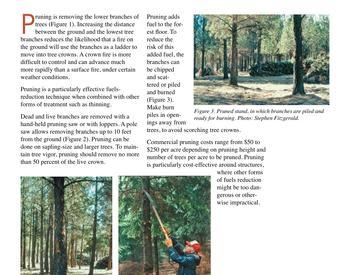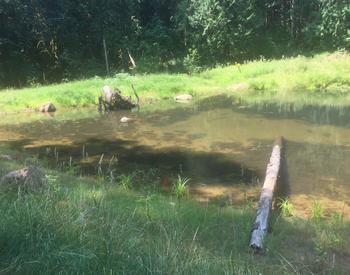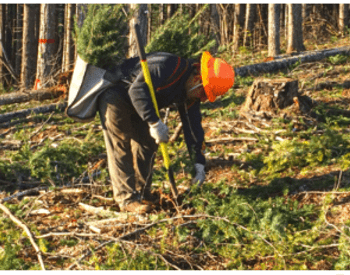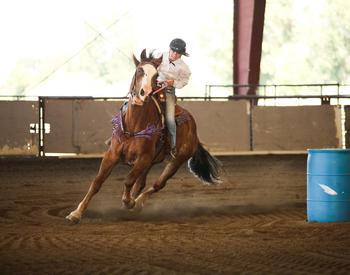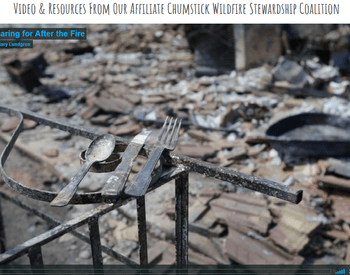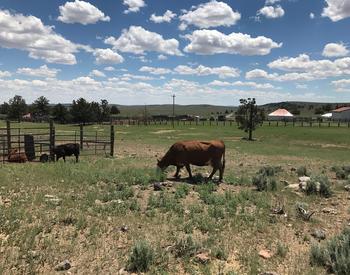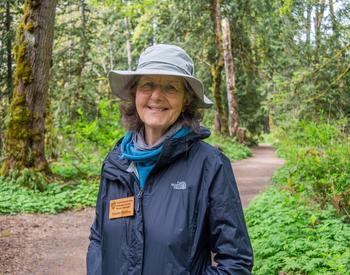Transcript
From the Oregon State University's Extension Service, you are listening to In the Woods with the Forestry and Natural Resources Program. This podcast brings the forest to listeners by sharing the stories and voices of forest scientists, land managers, and enthusiastic members of the public. Each episode, we will bring you research and science based information that aims to offer some insight into what we know and are still learning about forest science and management. Stick around to discover a new topic related to forests on each episode.
Thanks for joining us on another episode of In the Woods. I'm Lauren Grand, Oregon State University Extension Forester and Associate Professor of Practice and I'll be your host for today's episode. Today's episode is all about partnerships with tribal nations, and in this episode we hope to put Dr. Eisenberg's teachings of Indigenous knowledge from our last episode into action by discovering ways to respectfully work in partnership with tribal nations.
As a reminder, Dr. Eisenberg is the Oregon State University College of Forestry's Associate Dean for Inclusive Excellence and Maybelle Clark Macdonald Director of Tribal Initiatives in Natural Resources.
Dr. Eisenberg, tell us a little bit about yourself and how you developed your passion around natural resources and collaborative partnerships. Yes. Um, I'm a first generation student. I'm Native American, um, of Raramuri and Western Apache mixed heritage. And um, as a little girl, when I was three years old, uh, my dad took me in the woods, into the woods to get out of going to church.
He made the excuse to my mom that I need to take Cristina for a walk in the woods. And he took me into an old growth cedar forest in Stanley Park in Vancouver, BC. And it was, it changed my life, that deep immersion in the woods. And I was three years old and I vividly remember that whole walk. And I was curious about everything in that forest.
The understory, the big cedars. And, um, and I, from that point on, I knew that I wanted whatever I ended up doing with the rest of my life, that I wanted to be in the woods. What a great story. Isn't it so great when you find your connection so young in life and are able to find a career that you really enjoy based on that love that you found as such a young person?
Well, now that we've learned a little bit more about you, um, we're... doing this podcast a little bit differently than typical. We'll be having Cristina do a presentation. It is coupled with visuals that will be available on our website via a YouTube link. So if you are interested in seeing her presentation as well as hearing it, please visit our website at inthewoodspodcast.com so you can follow along with her slides as well.
Take it away, Cristina. All right. So today we're going to talk about best practices for partnering with tribal nations to restore climate resiliency. This presentation builds on my earlier talk about Indigenous knowledge, what it is, and why it matters.
My native name is Mount Star Woman. I'm of mixed Rarámuri and Western Apache heritage. And I'm the Associate Dean for Inclusive Excellence and Maybelle Clark Macdonald Director of Tribal Initiatives at the Oregon State University, College of Forestry. So, Indigenous knowledge is defined as knowledge and practices passed orally from generation to generation, informed by strong cultural memories, sensitivity to change, and values that include reciprocity.
Rooted in spiritual health, culture, and language, Indigenous knowledge is a way of life. It's a world view. This is a definition by Robin Wall Kimmerer, who is an eminent, uh, Native American woman in science. Uh, she just recently got a MacArthur Fellowship, which is also known as the Genius Award. And her fellowship is for her to explore more deeply how Indigenous knowledge can be used in today's world.
Uh, the image on the right is a painting by Christi Belcourt, uh, a Canadian Indigenous artist. And that is The Wisdom of the Universe is the title of that painting. And it depicts how the Indigenous view of the natural world is everything being connected. So I'm going to give you some federal policy context.
So why these partnerships with tribal nations are being prioritized the way they are now and what are the policy and legal implications of those partnerships and how we can address them. And that is what this presentation is about. I will also provide some examples of how these partnerships Um, have been implemented.
So in July, 2021, President Biden created the Justice 40 initiative. And that initiative calls for, um, underrepresented communities to receive equity and inclusion and funding to help build capacity within them throughout the United States. By partnering with them, and this is not just indigenous communities, it's Latinx communities, black communities, any areas where there is, have been identified as economically depressed, um, and so that's the first piece of policy.
Then also in 2021, the White House Office of Science and Technology Policy Council on Environmental Quality. Released a memorandum on Indigenous knowledge and federal decision making that called for incorporating Indigenous knowledge in everything every government agency does. At the time, Indigenous knowledge was referred to ITEK, Indigenous and Tribal Ecological Knowledge.
They have since changed how they refer to it as Indigenous knowledge based on guidance from a thousand Native American leaders. In November of 2022, the White House CEQ released another memo with guidance on how to partner with tribal nations. Now, I'll back up. In 2021, there's this, um, you know, memorandum on, White House memorandum on how all agencies need to incorporate Indigenous knowledge into their programs, but no instructions on how to do that, and nobody really knew how to do that ethically and in a way that was legally acceptable.
So, the memorandum followed a year later. And then also in 2022, there was a joint secretarial order that, um, agencies, federal agencies should partner with tribes in co stewardship of management of federal lands and waters. Now these orders are not just about federal agencies. They apply to anybody who has federal funding, which is most professors at land grant universities have federal funding.
So you can see the implications of these, um, policies are profound to all of us. And additionally, when working on state lands, state lands need to abide by federal policies. And federal policies having to do with Indigenous people states of figuring out how they are going to be applying the policies that I brought up right now.
So that we're in a state of rapid change nationally in terms of how indigenous peoples are treated and with a focus on federally recognized tribes and there's 574 federally recognized tribes in the United States, but there's also hundreds and hundreds of law and federally recognized tribes about that.
So those are the Labor Day fires in Oregon, and they were a series of mega fires that exploded over a three day period during Labor Day weekend in 2020, and they were related to anthropogenic climate change, and events like that, and that's an image of one of those fires, are powerful reminders that what we're doing isn't really working in terms of managing our natural resources and our forests and other landscapes are not resilient to climate change.
So we need to figure out together, how do we, how do we manage them and steward them for climate resiliency? And that's where indigenous knowledge can come in as a very powerful tool. However, indigenous knowledge, as, as widely as it's being recognized as important, there's, there's a challenge here in that it represents a very different worldview than Western science.
Western science arose 2,000 years ago, um, the Greek philosophers over 2,000 years ago, uh, created the foundational philosophical principles of, what is, what our science is based on, and science is a, it's based very much rooted in philosophical thought, um, indigenous knowledge and western science can be seen as polar opposites, or a chasm, if you will. And I'm going to talk about how we, how they're not really such polar opposites, but let's, let's start with, you know, the first appearances are, and it also depends on how Western science and indigenous knowledge are being implemented.
So indigenous knowledge is abstract. Western science is very concrete. It's about these facts that are measurable and are, you know, quantifiable, very obvious, very evident. Indigenous knowledge is about ideas, and it's based on oral histories, stories. That to Western scientists can seem, you know, how could that possibly be true?
You know, it doesn't make sense. How can we use that to develop a research project? Indigenous knowledge can be seen as it's qualitative. It's as much about how people feel about something and stories that they have about playing in the woods with kids, as it is about what is happening, uh, in forest lands and grasslands today on their reservations.
Western science is very quantitative. It's about numbers, points on a map. Um, ITEK, indigenous knowledge is inclusive, so the whole community is involved in making decisions about natural resources. That means elders, young children. It's not this top down thing where, you know, somebody who has a graduate degree in natural resources, who's a tribal member, makes all the decisions, and it's a community thing.
Western science is very explicit. There's a lead principal investigator, they come up with their findings, they present their findings, and it's, it's, there's this hierarchy in academia and Western science is part of that hierarchy. Indigenous knowledge is intuitive. Western science is intellectual. So intuitive, I mean, based on gut feelings.
Uh, Western science is based on these intellectual logic arguments, hypotheses. Um, Indigenous knowledge is diachronic, which means of long duration, intergenerational. Um, Western science is synchronic, which means short time series, broad generalities. So, the average, according to NSF grant, is for 2.4 years in funding.
That is not very long. And in the indigenous view of the world, it takes many years to restore a landscape that's been degraded. Like, at least 20 years. Maybe a couple human generations. Indigenous knowledge has humans as part of nature, embedded in nature, and Western science has humans as separate from nature because we have to, we're looking at nature as observers and measuring what we see in a very, um, quantitative manner, and we do not want to bias our findings by, with our feelings, let's say, or our personal worldview.
Uh, Indigenous knowledge, the data are, belong to the whole community. With Western science, the data belong to the lead PI and the institution, which whom they work. Indigenous knowledge is holistic, Western science is linear, um, the hypothesis testing. And how one works through, even in adaptive management, is typically rather linear.
Indigenous knowledge is matriarchal, Western science is patriarchal, Indigenous knowledge is value driven, it's, um, unbiased in Western science. It's part of daily life, indigenous knowledge. In Western science, it's separate from our daily lives. It's Aristotelian hypothesis testing. And indigenous knowledge is expansive.
It's boundless. It's everything. Western science is reductionistic. Like, you know, we tell our graduate students, focus, you know, have very specific research questions, and don't, don't worry about all this other stuff. So, these are, these are some generalities. What we're doing today in places like the College of Forestry at Oregon State is we are meshing these different ways of studying the natural world and coming up with some astonishing strategies.
So here's the worldviews. There is the egocentric worldview. And that's, uh, the Western worldview, where humans can control everything, we're, you know, superior to the natural world, we have a brain in our heads that tells us that, right? Versus the indigenous worldview is very eco centric, we're embedded in nature.
And not only are we embedded in nature, but, um, we are the dumbest organism in the natural world. So, fungi, fungi have greater, deeper wisdom than we do about how to live sustainably. And so this humility is part of indigenous knowledge and the indigenous worldview. And we prioritize the rights of nature, and that's the reciprocity piece, people are embedded in nature and we are morally obligated to care for nature.
When in the Western worldview, nature, the economy and people all come together and they all have to work together to benefit, you know, for mutual benefit. So it's a different way of, of prioritizing things. So Two Eyed Seeing is a paradigm for how we can bring these two worlds together, and it comes out of Canadian education and human health, uh, academic systems in Eastern Canada, and Bartlett et al.
Was a researcher at one of the Canadian universities who partnered with tribal elders because what was happening is that human health policies and practices in Canada and also education policies and practices were failing, were not effective when applied to Indigenous people. And so First Nations in Canada.
Um, we're not responding to this Western paradigm or how education could be most effective. What could be done to improve human health? So Bartlett engaged an elder and together they created this two eyed seeing model. And it was applied by Reed to fisheries in Canada. And now it's being applied more widely and broadly, but it was originally a human health and social science. Um, an education model.
So you start with mutual research interests. A problem that you both share. The forests are burning up and they're burning up in a way that they haven't before. What are we going to do about it? Then you come together and you do this from the very beginning. You don't have Western scientists, um, you know, figure all of a plan out first and then bring in tribal partners.
You identify what tools you want to use. Let's use remote sensing, let's use, let's use LIDAR data, let's work with culturally significant plants to see how they might stabilize the soil post fire. You co develop the research, so yes, there will be hypotheses. And Western science is this amazing, powerful tool that Indigenous people highly respect Western science, but on its own, it does not have the depth and wisdom to give us the solutions that we need.
Or guide us in the best directions. Together, you have these amazing Western science tools, and then you have this, this deep, intuitive knowledge that goes back millennia. And you can imagine what had happened here, the promise of this. And I'll quickly share a story to illustrate the validity of indigenous knowledge.
In the project in Canada, in Alberta, southwest Alberta, uh, I'd been measuring, uh, forest, the forest community there for about a decade, had all kinds of data, thousands of plots, and the, I was working in Waterton Lakes National Park, and the park was setting prescribed burns to my specifications to mimic cultural burning.
So we had all these data and 2017, the Kenow wildfire, a megafire that is one of the most severe wildfires that have burned in North America in history, recorded history, uh, burned our entire study site. And all of this time that I'd been working in that study site, Tribal elders were out in the field with me, many of my field technicians were, um, Blackfoot, Kainai First Nation members, and they would tell me, you know, there used to be a buffalo camp over here, and there used to be lots of bison in this landscape, and our, and our ancestors used to hunt them over here.
Meanwhile, the Western science paradigm was that that was never a buffalo habitat, bison habitat, and there wasn't, there was no evidence of, you know, humans hunting down there. So this wildfire, it, um, the megafire that happened in 2017, ripped off, burned off, blew off, you know, half a meter of soil, and revealed that every single thing that the elders had been sharing as part of their oral tradition was exactly correct.
And it was not just exactly correct in terms of its validity. It was exactly correct in terms of locations. You could have GPS'd it with like total accuracy. So those oral traditions are data and you use them in research co development and you create your research design based on things like some of the oral histories of the area.
Then you co evaluate your results of your research as you're implementing it and the community validates it. You develop shared recognition across cultures of what are the mutual benefits of this work. And this leads to very deep trust and long term relationships across cultures. And this is intended to be a cycle that repeats and repeats and repeats and can continue over time to deepen these relationships.
And so this is the Two Eyed Seeing model. It is good to step back and see what the history in the U. S. is of these rights, tribal sovereignty rights. And this then shapes how we are able to work with Indigenous knowledge in partnerships. So, in 1887, the Dawes Act, also known as the General Allotment Act, recognized tribal sovereignty.
And it defines the right of indigenous peoples to self governance and self determination. This act, um, identified, designated tribal nations as nations with sovereignty. So by nations, a nation like the United States is a nation. Um, it also made it so that people had to have, uh, uh, tribal members had to have an allocated amount of land.
So they were allotted land, and if you were not a tribal member with a certain amount of land, then you were not able to have land. That was the, the darker side of the Dawes Act. This, um, the Dawes Act was implemented, the tribal sovereignty part, very unevenly. And then, um, there were termination policies in the 1950s to 1960s, the idea being, we've helped tribes long enough, they can fend for themselves now.
They should be totally independent. Well, termination did not go through. Although, quite a few tribes in Oregon were terminated and then were later reinstated. Um, in 1975, after the 60s, in the 70s, um, Congress started becoming very aware of the, the rights of tribal nations. And this had to do with, um, a lot of work on the part of tribal nations to make sure that what was promised in the Dawes Act was delivered on.
So, there was the Indian Self Determination and Education Assistance Act, which guaranteed education for, um, tribal members. There was the Tribal Self Governance Act that specified more clearly what it meant to be a tribal nation and reinstated sovereignty rights and gave them more right to manage their lands.
But these, all of this has been not very well respected or implemented until now. So the, the presidential memos, the CEQ, um, you know, memorandum, um, they all lay out we have to partner with tribal nations and we have to do it in a way that honors sovereignty, rights. And one of those memos explains these, these are guidelines that everyone must follow.
In the College of Forestry, we didn't have any formal policies on this, and there currently are no formal policies on this at Oregon State University on how to partner with tribal nations. Yet our grants that we're getting from the federal government, many of them require that we help or strongly recommend tribal partnerships.
So these are the principles we came up with in the College of Forestry, and this was done by our whole community. Um, I convened a task force that was very diverse, and it consisted of College of Forestry members who were some were students, some were very senior professors, there were, um, several Native American individuals, there were people from a variety of disciplines, social sciences, fire ecologists.
Community Colleges, Extension folks, and this is what we came up with. So, this is based on federal guidance, but it goes much deeper than that. And, currently, the federal government asked me to share these principles that we created, um, together, and they are wanting to use them to deepen the federal policies on this.
And the other thing I should add is that this was a very happy process that the community and the College of Forestry was so deeply engaged in this process. And it was There was this willingness and this recognition of we have to do something and we want to do the right thing and we are one of the top schools of forestry in the world and so this is a way for us to show our leadership.
So acknowledge historical context of past injustices. That means acknowledging the genocide that happened and the land that was taken. Practice early and sustain engagement. So from the first moment that a researcher has an idea, an inkling, an extension agent has an idea of something they want to do that involves Indigenous knowledge, she builds those relationships with the tribal communities.
And ask them, you know, what are your priorities? What do you want to do? Let, let's figure this out together. Remember that two eyed seeing model. You start from the very beginning to share ideas across cultures. You earn and maintain trust by being open and honest about everything. You respect that there are different processes than world views.
Guess what? Indian time is a real thing. In the native world, processes don't operate in such short timespans or in such a linear manner. Recognize and respond to and adapt to challenges with cultural humility. We all make mistakes and as we work through what it takes to partner with a tribal nation, the most important thing is to be humble across cultures, open to learning, and really wanting to do your very best, which means admitting when you don't know.
Um, Cultural humility is one of the tribal values that's most, most important, and when they see that on somebody who's non native, that immediately opens doors. Consider supporting co stewardship and co management partnerships. And these are types of partnerships that, um, that there would need to be a whole other, you know, in the woods presentation about this to get into them.
But there are ways to partner with tribal nations and, and they are described by the federal government and there's very different policies around them. Uh, co stewardship is let's work together and share power to figure out how we want to restore this patch of prairie let's say. Co management is more like a contract.
It says this tribe is getting this contract to deliver this work by this such and such a date. So, um, co management has been used with fisheries, um, restoring salmon to the Columbia River, for example. Co stewardship is more, um, used to restore resiliency to forests, let's say, like some of the Camas restoration work.
Support co production of knowledge. So you've got this federal grant. You are partnering with the tribal nation, and you're supposed to generate reports and journal peer reviewed journal articles. So, co production of knowledge means tribal partners are co authors on everything you produce. And by tribal members being co authors, that means elders.
That means people in the community who don't necessarily have a bachelor's degree, much less a PhD, but they're deep knowledge holders. It means tribal leaders in natural resources. You open it up to the community and then they tell you who wants to be involved as a co author. Also, don't come to a tribe asking for money.
Um, there's so much that has been taken from tribal nations. That, that doesn't sit very well and it doesn't go very far in terms of building trust. When you approach a tribe, you bring something to the table. And so if you have the opportunity to secure some funding, the first conversation should be, how can we best support you?
Offer jobs that are very well paying. If you are interviewing tribal elders, let's say, as part of the research, be aware that they are experts the same way, or even much more so than the top level scientists who typically get paid two to three hundred dollars an hour for their time when they're asked to consult about something.
And finally, share power and decision making authority with tribal partners. Um, the link on the bottom shows, um, is the link to the whole, um, report that we produced, and it's publicly accessible. So here's an example of Bridging the Chasm, um, Ecocultural Restoration, which braids ecological knowledge derived from practitioner experience, local and indigenous knowledge, and Western science.
And it's an intercultural collaboration, and in Oregon, this is being done, that's a Camas restoration project in Oregon, and there's a lot of extension work that has been done in this type of restoration work very effectively, and it does bridge that Chasm. Public lands of the future, um, they need to be managed for a broader array of ecological functions.
This is one of the megafires in Oregon, and, you know, by considering all types of knowledge, this leads to climate resilience, resilience to wildfire, and, but it requires these partnerships based on what I've seen. So I'm going to close with this example of a project that we have in the Pacific Northwest, the Tribal Conservation Corps pilot project, the Seeds of Success.
I'm the lead PI, Dean Tom DeLuca. Uh, is Co PI, so is Tom Kaye, an eminent restoration ecologist in Oregon and globally, really. We're fortunate to have his work on this project. Chris Dunn, who is a fire ecologist. Luhui Whitebear, who is a Native American and a professor at Oregon State University. Her background is in anthropology.
And Si Gao, who's a professor at Sacramento State. And she is a soil ecologist, and Tom is a soil ecologist, Tom DeLuca is a soil ecologist. It's, uh, to work with tribal nations on these ONC lands at the Oregon and California Railroad lands, those are the orange checkerboard lands, and on tribal lands that surround them, if we're invited to do so, or it's a three year project, we are hiring, uh, 30, up to 35 tribal conservation corps fellows per year, these are very well paid fellowships for tribal members. Uh, provide we can provide up to 60 jobs per year, mostly for Native Americans, uh, STEM education opportunities for tribal students.
We, the objective is to collect seeds for restoration and seeds of native plants, uh, to stabilize forests post fire. We are putting in vegetation plots, forest plots, soil analysis, um, and pollinator surveys and wildlife studies, and it's an extensive project, but it's also a pilot project because it involves five tribal nations in western Oregon, and we call the principles, so we're working with each of them individually to find out what are your priorities and how do you want to see this evolve.
It's part of the Plant Conservation and Restoration Program, and here we are in the field. Last summer, it was amazing. And it's intended to support tribal youth and help the BLM with public land inventory, and co create an ecocultural restoration plan for public and tribal land, and increase awareness, public awareness of Indigenous knowledge and sovereignty rights and partnerships.
And to decolonize natural resource management. So what's happening in these pictures is Tom DeLuca is digging, uh, teaching people how to work with soil, dig a soil pit. And what we were looking for is evidence of cultural burning in the forest soils. And we found quite a lot of bits of carbon, um, that were left.
Some of them from these light cultural burns over the years, over millennia, and on the left you see some of the things we're doing. We're doing very, um, detailed soil analysis. So this is the very best Western science that we could possibly apply. Combined with indigenous knowledge, and we're braiding them together like a braid of sweetgrass.
So our policies are that we only work on tribal lands if we're invited to do so. Based on Indigenous cultural values, we do non invasive, non lethal sampling as much as possible to do no harm. Uh, the seeds collected on BLM land, um, for leased lands, we notify the people that hold those leases, the entities holding those leases, of our intent to collect seeds.
For tribal lands, we have MOUs with each tribal nation when we're working on their land. We collect the seeds of BLM priority species and on tribal land, uh, priority species that are also culturally significant species approved by the tribe's culture department collection. We only collect 1 percent of seeds present in a plant population per Indigenous knowledge principles.
All seeds go to the Bend National Seed Extractory and are stored there based on SOS policy. And all seeds collected on BLM will belong to the BLM to be used in restoration per Seeds of Success policies. So this is, um, based on the Seeds of Success program, which was created by Peggy Olwell and she has oversight for the BLM on over our project.
All seeds collected on tribal lands belong to the tribe to be used by the tribe for eco cultural restoration projects or however they wish. And that's it. Um, there are many other examples of effective partnering with tribal nations that are either early in the works or are already being implemented.
And this is a very exciting era. And I truly believe that if we come together across cultures respectfully, using Two Eyed Seeing, we are going to help steward a much more sustainable future for ourselves and for future generations. Thank you. Thank you. What an eye opening, um, presentation, um, thank you so much and we'll be sure again to share your, um, websites and contact information on our website.
Can I ask you a couple questions? Sure. How do you recommend somebody approach, um, a tribe or somebody from another culture, um, with an idea or a collaboration or project or just, you know, with the interest of building relationships? How is the respectful way to start doing that? Well, um, many organizations, like the state of Oregon, the state of Montana, federal agencies, there's many tribal liaisons.
And if you know of one that is related to what you want to do, I suggest consulting the tribal liaison. The tribal liaison. So, for example, the Oregon Department of Forestry has a tribal liaison, and that person, their job is to help connect people. And so that's one way to do it. You can also contact, so tribes have a flood of requests right now because one of the things I did not share in my presentations is that there's an enormous amount of funding right now for projects that involve partnering with tribal nations.
So a lot of people want to do this. Because they're excited about it, and because it's an opportunity, and because it's important to do this work, um, to find a path forward in terms of sustainability. Um, so, be very respectful that tribes maybe get ten requests a week like this. And it helps if you know somebody.
If you don't know anybody, you... Express cultural humility, acknowledge that you know that all tribes are very much under capacity in terms of staffing, and this is because tribal nations get a huge amount of requests for their time. So acknowledge that first, and ask if it's possible to visit and meet with them in person.
Because that is a preferred form of interaction and do so very respectfully. And one thing I recommend is saying to your tribal, uh, you know, you contact their natural resource department, um, lead, for example. It's a good place to start if this involves forestry or wildlife or, um, botany and, um, say, I would like to come and visit and talk about partnering.
Don't use the word collaborate because it, because of tribal sovereignty, it needs to be a partnership, um, on, in a way that works for you on your, on your community's terms. Get some guidance about how that might be. What I'm interested in is, um, agroforestry and how agroforestry projects might work on tribal land.
I'm just making that up, but you say what your research interest is and provide them with some background on yourself. The worst thing to say is, I'm Dr. So and so, and I'm an expert on X, Y, or Z, and I'd like to talk to you about how you know, my knowledge can help you create healthier lands.
Right. And, you know, that's a top down approach, right? But, um, the other thing that resonates very much for tribal members is if you say, I really don't know anything. You know, I, I, I, I know about this, but in terms of your lands, I don't know anything and I'm, I'd like to help, you know, and I'd like to part, you know, explore opportunities to partner across cultures.
So that level of humility, they seldom get that. And when they hear somebody talk that way, it opens many, many doors. Yeah, sounds like really approaching as, you know, you say with a partnership as opposed to, I have this idea and I need your help to make it work sort of approach. That's great. Um, I really enjoyed your description of, um, how indigenous knowledges is community based, in that everyone in the community is part of the decision making.
Um, even, you know, young children and maybe people who aren't, um, as involved in the stewardship pieces, or maybe, I guess it sounds like everyone is actually involved in the stewardship. Do you have an example or, um, a story of how that community dynamic works in the decision making that involves everyone in the group?
Yeah, I have a very personal story. So, um, when I was working in, in Canada, I was doing research in Waterton Lakes National Park, and it was funded in part by Parks Canada. And I'd written a book called The Wolf's Tooth, which was about trophic cascades or food web relationships. And there were stories in that book based on some of the experiences I've had in with wildlife.
They weren't intended to be stories, but they were me giving examples from my work in the field that illustrated some of the scientific concepts I was writing about. It was published by Island press. So, um, there was this tribal land that was immediately adjacent to the National Park and the National Park manager said to me, see that land, don't ever set foot on it.
It belongs to the blood tribe or the also known as the Kainai First Nation, also known as the Blackfoot. And what had happened is researchers, um, who were from major universities had done terrible things, had gone on there to do research and had, like, introduced non native species, not share their data with the tribe, um, manipulated things in there without telling the tribe, you know, to do experiments.
And so they hadn't allowed anybody on their land since, um, 1960 or so. And so I got this on social media, this message from a tribal elder who's also on the tribal council. The name was Narcisse Blood. He's passed since then, but he said, "Yo, um, I think the work you're doing is really cool. I read your book. Can I join you in the field? And I'd like you to show me a tropic cascade."
So I was looking at how wolves shape whole ecosystems and the role of cultural burning in that. So, uh, he joined me with his wife. Um, I made them a meal from an elk that I hunted, meat of an elk that I hunted. And we swapped stories while I was cooking.
At the end of the night, he said, I'd like you to work on our land. I didn't even know what that meant. I, when I did some research, I learned nobody's worked on their land. Nobody's been allowed on there since 1960. So it was a big thing, and I had to create a research proposal. Um, Narcisse passed in a tragic car accident.
Um, the, uh, Director of Natural Resources, he introduced me to her before his accident, and she joined me in the field, and she vetted my proposal, and so, and she always had her daughter with her. Her daughter is Monroe Potts. She's the young woman in one of the slides I showed. She's now going to be a student at the College of Forestry, but back then she was like nine years old.
And so, um, what happened is that my proposal came up before the Tribal Council, and they were debating it, and there was lack of consensus about whether they wanted to approve it, even though it was an invited proposal and Narcisse had supported it and it's highly, highly respected. And so Ken, uh, the natural resource director with their, with their daughter in the audience and the tribal chair turns to the little girl and says, so what do you think of this lady?
Can we trust her? And Monroe said, "Well, she's like our mother, like, we could trust her," and so then the council voted and it was unanimous. We approved. So that's an example. That would never happen in the Western world, you know, that's not how we make decisions, right? Right. So, um. They wouldn't even have the child in the room.
Yeah. And so now Monroe is, um, going to be, she started already. She's a, a sophomore. Uh, she did a year of university at the University of Lethbridge, and she wants to get a PhD in ethnobotany. Wonderful. And she became my lead technician. She worked for me for many years. Um, so that's how things work in Indian countries.
That's a great, what a wonderful story. Thank you for sharing your experience. And I guess as, um, so as a non Indigenous member of a university, um, what's the best way that I can incorporate, you know, some Indigenous knowledge and practices in a respectful way to some of my classes with, you know, I work with small landowners, um, around the state and some of them are probably not aware of many of these practices or, um, or, um, knowledge.
And so how can I, you know, start to increase awareness without, in a respectful way, without, you know, speaking for anyone. So, I work really closely with Holly Ober, um, who is the Dean of Outreach, Associate Dean of Outreach. And who leads the extension program in the Oregon extension program is the largest one in the nation.
It's amazing. And I, I work with her team. I also work with Emily Jane Davis, who is meeting, you know, a fire initiative of, and she's, you know, a leader in extension. Um, so I do trainings for Holly. I meet with her staff, um, large extension staff. I meet with them like quarterly and we have conversations, uh, several of the extension folks were involved in developing those principles and best practices.
And in fact, the edits that they provided were all like what they wanted is to see more rigor and more acknowledgement of the challenges in the past and how, how delicate trust is and how to build trust. So for you, um, in response to your question or anybody seeking to do that. It's about educating the public, and the common ground that unites us is that ecosystems are in deep trouble right now, you know, we're experiencing things that are unprecedented, like the Labor Day fires, um, if you're a small landowner.
You're not very resilient economically, and so, you know, most people care very deeply about their lands. Some of them are multi generational folks. Uh, we have some forest land in Montana that, where we've lived for 25 years, and we still have those, that land, and, you know, we got to, we did a restoration project there.
So, come together around that common ground. And then talk about multiple ways of knowing. There's some great reading material, um, I wrote a story for, um, the Society of American Foresters for their magazine on indigenous knowledge and how landowners can apply it. The book, uh, Braiding Sweetgrass by Robin Wall Kimmerer, it's an excellent book to share with folks.
And then to work with, um, members, leaders in the tribal community to help create educational opportunities for them to bring them out. And have like a community event where, you know, sit around the fire circle and talk, right, and exchange ideas. So those are some suggestions. I'd love to have an event like that sitting around the campfire and exchanging ideas.
That sounds like it could be one of the best events in a long time. Great ideas. Thank you so much. Um, well, is there anything else that you thought of that you might want to share in relation to, um, your talk? Um, the tribal nation. They welcome these partnerships, if they're done right, and if they're done respectfully.
And, you know, I, I strongly encourage folks to explore their building these relationships. Don't hold back. And if people have any questions or doubts. Am I doing this right? Read the Principles and Best Practices. Read Robin Wall Kimmerer's book, Brains and Breaths. Um, and, you know, reach out to the Extension folks in your area because they, all of you collectively, now I, we, um, hold a lot of wisdom about these partnerships and the importance of, of doing them ethically and right.
So, um, build community around that. Well, thank you so much. I really learned so much and I'm so glad we were able to share this information to, um, help support creating partnerships and building information more and sharing more information and education for people around Indigenous knowledge.
Um, I'm so glad you were able to join us today. Thank you. Thank you, Lauren. It's been such a pleasure talking with you. As you are listening today, if any questions came up or we didn't cover a specific topic related to indigenous knowledge that you are interested in, please drop us a comment or send us a message on our website at inthewoodspodcast.org. Alright, well, as usual, we have a few final questions that we ask to all of our guests.
Did you know that the In the Woods podcast won an award? That's right, we've been nationally recognized by our peers as being one of the leaders in providing natural resources content and education through a podcast. But, what do you think? Do you like the topics we've been covering? Are there topics we're missing that you'd like us to cover?
How's the quality of the episodes? We've developed a short survey where you can let us know how you feel. Head over to our website at inthewoodspodcast.org to access the survey, or you can find a link in this episode's show notes. The survey should only take about 5 to 10 minutes for you to complete, and when you're done, you'll have the option to enter into a drawing to win some In the Woods swag.
We've got magnets, stickers, coffee mugs, and t shirts for you to choose from. We really need your help, so please take a moment to fill out the survey. The feedback we receive will not only help with improving the podcast, but also help us in the Forestry and Natural Resources Extension Program to ensure we're reaching all our audiences.
We look forward to bringing you more engaging content on a wide range of topics with guests from diverse backgrounds, experiences, and expertise. From all of us at In the Woods, thanks again for listening. So what's your favorite tree? Uh, that, um, the, the larch tree, the western larch. I love western larches and how they turn, their needles turn golden in the fall.
That's my favorite tree. In the, um, Pacific Northwest and the inland West that they're a tree that, you know, it's, it's like grows in these groves that are very open and the understory has amazing grass and herbs and, yeah, everything about them and their habitat and they sometimes grow on the shoulder of a mountain where we live in Montana, um, it's in one of the areas where it's a very healthy population of Western Larch.
And my favorite time of year is the fall when they all turn golden. The Western Larch is such a gorgeous tree, and it's pretty popular on the podcast. I, myself, haven't had the opportunity to, um, be, live in a place where, uh, it grows to be able to see it very often. I'll have to go visit in the fall.
Um, and see the golden leaves. Great. So, um, is there a interesting tool that you or thing that you bring with you in the field, whether it's in your cruiser vest or field kit or in your pocket? Yes, it's my botany hand lens and, but it has a lanyard on it that it used to have like the regular, you know, plain leather lanyard.
And one day when we came in from the fields after working up, we were working in the Kenow wildfire, wildfire landscape, assessing what plants were fire response. Um, I was making a dinner, which consisted mostly of tribal members from the Kainai First Nation. And I have an open doors policy, so in keeping with tribal values, um, indigenous values.
And meal times, anybody's welcome. So people can invite their families over to join us. And I was making a meal of wild bison meat and I was making like a bison stew. And as I was cooking, um, one of the, my field technician's moms, uh, you know, she and her family came to join us for dinner, and she's sitting at the kitchen table, and we were chatting, and I, she had brought her beading supplies with her, and I saw her doing some beading.
I wasn't paying attention, but she beaded this lanyard, a gorgeous beaded lanyard for my hand lens. And so, and she said, this is to thank you for what you're doing for my daughter by mentoring her. So, um, that, that hand lens, I always would have it with me anyway, but now it's especially precious because it represents a 7th generation principle.
Wow, that's wonderful. And okay, and so, and lastly, um, are there any, you shared a lot of resources during your presentation, but, uh, are there any additional ones that you can think of that you might recommend to listeners that are looking to dive a little bit deeper into learning more about indigenous knowledge or creating partnerships, um, with indigenous knowledge.
Yeah, certainly Robin Wall Kimmerer's book, Braiding Sweetgrass, is a really good place to start. Um, it's written for a general audience and it's filled with stories and it's also filled with science. Um, How It Is, um, is this great book is it by, um, V. F. Cordova and it is, um, she's a philosopher who was, uh, Dine.
She had since passed. She wrote this book about indigenous thought and indigenous knowledge. And she's a very formally trained, um, you know, philosopher in the Western tradition. And she wrote this book that, like, if you want to understand indigenous knowledge, and there's poems in that book, right? It's, it's written in a very decolonized manner, but she's a brilliant scholar.
And, um, that book, when people start saying, well, I don't really understand how this works, or I hand them a copy of that book, uh, Cordova's book, V. F. Cordova. And then there's another one called Traditional Ecological Knowledge. And this is by Melissa Nelson, is the editor, she's indigenous and Dan Shilling, and there's some of the faculty in the College of Forestry are co authors of some of the essays in there.
Um, and it, the subtitle is Learning from Indigenous Practices for Environmental Sustainability. Um, but that's one of those books to dip into. And, you know, peruse, the chapters, and there's some really inspiring and enlightening stuff in there. It's a bit more scholarly than Robin's book, um, you know, most people read her book and then they want to read more.
So, these are, those other two are really good resources. Thank you for the suggestions. Um, we'll be sure to put the books up on the website under this episode to make sure that everybody can find a copy of them if they're interested. So, um, with that, I just wanted to thank you so much, Cristina, for joining us.
And, um, being willing to share your, um, thoughts and wisdom on the podcast. Well, this concludes another episode of In the Woods. Join us in a couple of weeks to explore another topic on Oregon's amazing forests. But until then, what's in your woods?
Thank you so much for listening! Show notes with links, mentioned on each episode, are available on our website @inthewoodspodcast.org. We'd love to hear from you. Visit the tell Us What You Think tab on our website to leave us a comment, suggest a guest or topic, or ask a question that can be featured in a future episode.
And give us your feedback by filling out our survey. The In the Woods Podcast is produced by Lauren Grand, Jacob Putney, Scott Leavengood, and Stephen Fitzgerald. Who are all members of the Oregon State University Forestry and Natural Resources Extension Team. Episodes are edited and produced by Kellan Soriano.
Music for In the Woods was composed by Jeffrey Hino. And graphic design was created by Christina Friehauf. We hope you enjoyed the episode and can't wait to talk to you again next time.
Until then, what's in your woods?
In this episode, Lauren Grand is joined once again by Cristina Eisenberg to discuss how creating relationships with indigenous tribes can help strengthen Western science methodologies to create natural ecosystem resiliency.

